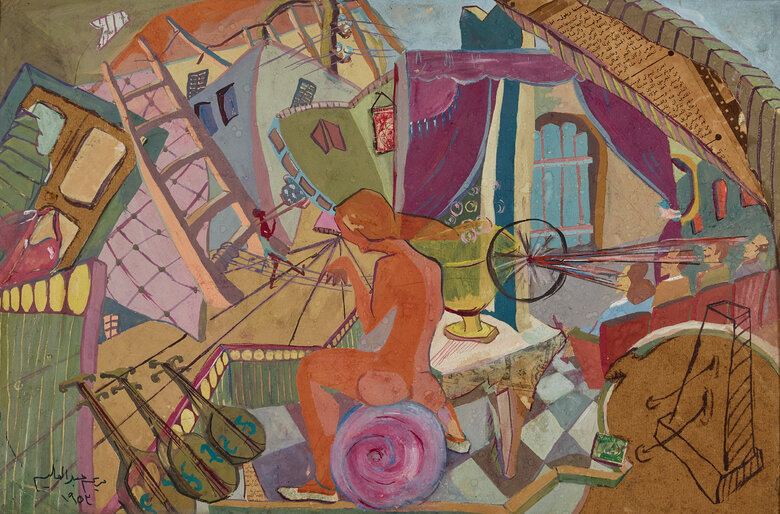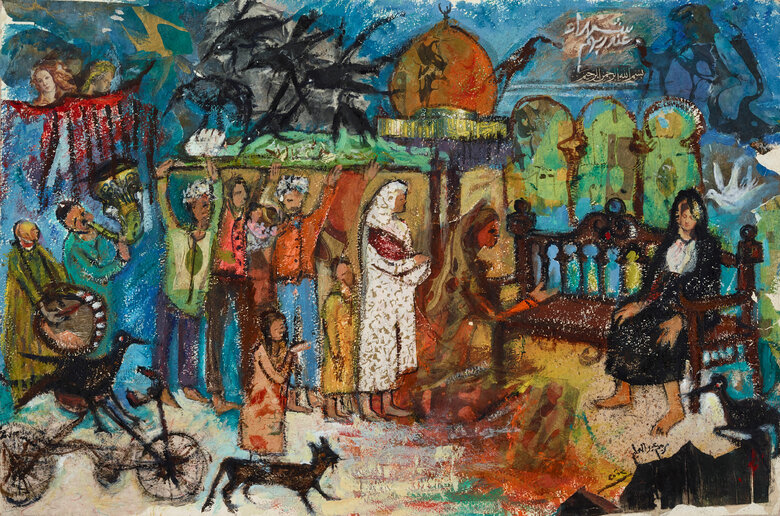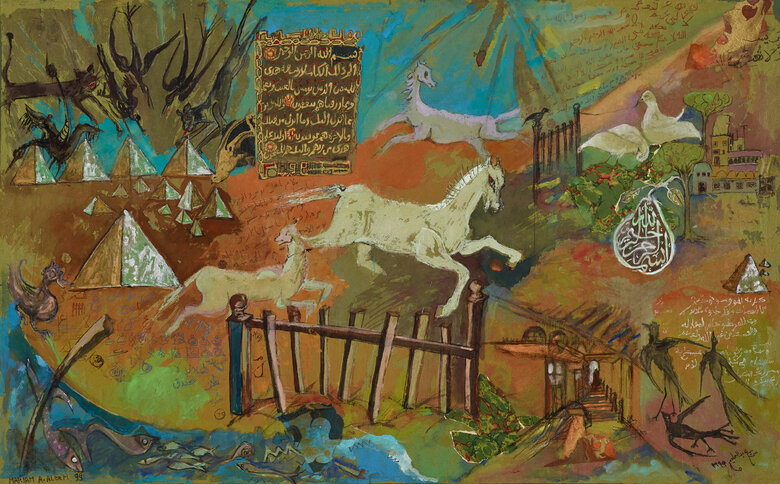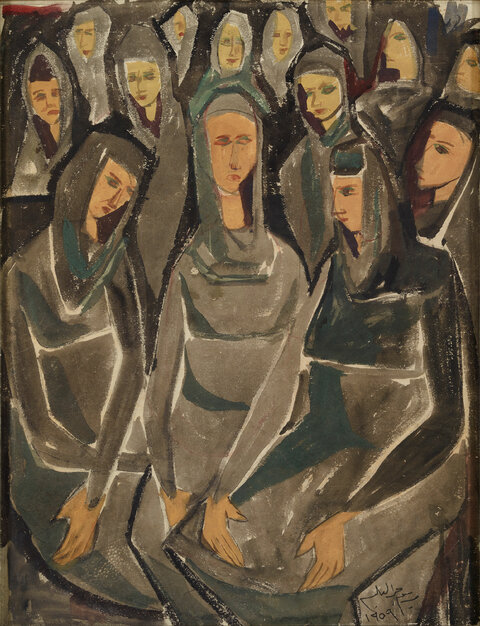Written by Arthur Debsi Born in 1930 in Alexandria, Mariam Abdel Aleem received her BA from the Faculty of Fine Arts at Cairo University in 1954, and completed her master of Fine Arts in graphic...

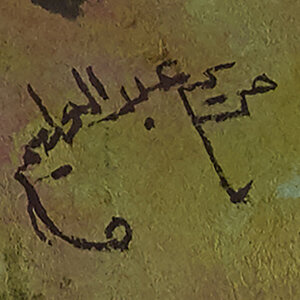
MARIAM ABDEL ALEEM, Egypt (1930 - 2010)
Bio
Written by Arthur Debsi
Born in 1930 in Alexandria, Mariam Abdel Aleem received her BA from the Faculty of Fine Arts at Cairo University in 1954, and completed her master of Fine Arts in graphic printing at the University of Southern California in 1957. Back to Egypt one year later, she started a long and active career in higher education. She began this career as a printmaking teacher at the Faculty of Fine Arts in Alexandria. In 1968, she was appointed assistant professor and head of the printmaking department of the same institution before being granted a full professorship title in 1975. She then founded and led, the design department, from 1985 to 1990. Later, she earned a Ph.D. in Art History from Helwan University in Cairo and again pursued further graduate studies at the University of Southern California, and eventually at Pratt Institute of New York.
Mariam Abdel Aleem was invited to establish a department of artistic education in the Girls' College in Jeddah, Saudi Arabia, and worked as a visiting professor in 1985.
During the 20th century, Egypt was a central creative space in the Arab world where many and important artistic movements arose and developed. However, the oeuvre of Mariam Abdel Aleem is not specifically affiliated to one of those, although she vividly showed her attachment to her roots both Egyptian and Islamic. In June 1953, the monarchy was abolished and the Republic of Egypt was established[1], ending almost one century of British occupation. Therefore, a strong sense of dignity and nationhood spread all around the country, and deeply marked the arts and culture as well. At that time, Abdel Aleem was newly graduated and undoubtedly lived in this major historical context but she wouldn’t produce an art that follows nationalistic ideals. In fact, the topics that she tackled refer to life in Egypt with its streets, its people and vehicles, but she would focus more on the technique to use. She carried out her graphic work in diverse ways, engraving on zinc, copper, stone and wood. Graphic art that she practiced is a form of art, which includes photography, drawing, printmaking, and has its early origins in ancient China, Greece, and Egypt[2]. The ancient Egyptian mortuary text called ‘Book of the Dead’, completed during the 16th century BCE, is a perfect example proving that the style and technique from graphic art is part of an artistic heritage for modern and contemporary Egyptian artists. As a part of them, Mariam Abdel Aleem chose to celebrate the Egyptian identity in a method based on academic research, experimenting with techniques, and the constant use of Arabic calligraphy.
Although she doesn’t use pure hieroglyphic symbols in her works, the painter makes reference to the animated and colorful stories illustrated on papyrus from antiquity, by showing a particular interest in their narrations such as in the work Memories (1953), part of the Dalloul Art Foundation. Here, she represented in a one-dimensional perspective the theme of self-introspection – maybe her own, by ascribing the thoughts, and memories of an individual. She created a surrealistic scene by interweaving straight and curving lines and overlaying various objects, and characters. The space is also confusing since she played with the inside and outside. The artist integrated elements from the popular culture like the lute, or from the Islamic artistic tradition with the Arabic script on the top right corner of the composition. In the Islamic civilization, writing occupies a fundamental place, namely sacred, as it is initially the physical appearance of the divine word transcribed in the Holy Quran[3].
In the work on paper entitled Arab awakening (1999), at the Dalloul Art Foundation, Mariam Abdel Aleem continued the ancient Egyptian tradition, which consists of combining images and script. She depicted another fantastic world made up of pyramids, horses and mysterious hybrid creatures, and gave it a religious dimension. In the center top, she drew a page, on which appear the first five verses of Sourat Al-Baqarah (The Cow), an essential surah of the Holy Quran. Indeed, it is the second and longest surah, which sets out the principles of the Muslim community, addressing multiple themes like marriage, divorce, fast etc. She also made calligraphy of the introductive formula ‘Bismillah al-Rahman al-Rahim’ – ‘In the name of God, the Most Gracious, the Most Merciful’ – in a shape of a fruit hanging from a tree. Some writings are visible a little over the composition as if she wrote on the paper. The treatment of the work consequently resembles the one of a manuscript with a symbolic dimension, almost esoteric. From her experience in Saudi Arabia, Abdel Aleem demonstrated more visibly references to Islam. Employing collages and a palette of bright colors, she executed the piece Al-Shahid in 2002, also at the Dalloul Art Foundation. In Arabic, the term ‘al-shahid’ means ‘martyr’ who dies for bearing the religious testimony, ‘al-shahada’[4]. Followed by two musicians, the people are carrying the deceased body and walk towards a woman sitting on a bench, dressed in black, who is probably a relative. In addition to some writings, the artist also included some typical architectural elements such as the horseshoe arches and a dome surmounted by the Islamic crescent, both in the background. The richness of Islamic culture and civilization was the basis for the artist to adapt a traditional artistic practice into a contemporary form. Hence, she invented a visual language, which corresponds to another way of thinking and making art in order to let the imagination free.
Mariam Abdel Aleem passed away in 2010.
[1] Tomiche, Nada. “Chapitre IV. Les Origines Politiques De l’Égypte Moderne” in Groupe de Recherches Et D’Études sur le Proche-Orient (dir.). L’Égypte d’aujourd’hui : Permanence et changements, 1805-1976. Aix-en-Provence, France: Institut de recherches et d’études sur les mondes arabes et musulmans, 1977. https://books.openedition.org/iremam/792?lang=fr. [PP.85-105]
[2] Meggs, Philip B. “Graphic Design.” Encyclopædia Britannica. Encyclopædia Britannica, inc., April 2, 2020. https://www.britannica.com/art/graphic-design.
[3] Eigner, Saeb. 2011. Art of the Middle-East, Modern and Contemporary Art of the Arab World and Iran. London, UK: Merell Publishers Limited. [P.63]
[4] Aggoun, Atmane. “Le Martyr En Islam. Considérations Générales. ” in Études Sur La Mort, Vol. 130, no.2. Paris, France : L’Esprit Du Temps, 2006, pp. 55-60. Accessed May 8, 2020. https://www.cairn.info/revue-e....
Sources
Aggoun, Atmane. “Le Martyr En Islam. Considérations Générales.” in Études Sur La Mort, Vol. 130, no.2. Paris, France : L’Esprit Du Temps, 2006, pp. 55-60. Accessed May 8, 2020. https://www.cairn.info/revue-etudes-sur-la-mort-2006-2-page-55.htm.
Eigner, Saeb. 2011. Art of the Middle-East, Modern and Contemporary Art of the Arab World and Iran. London, UK: Merell Publishers Limited.
FineArt Sector - Biographies - Mariam Mohamed Abdel-Aleem. Accessed May 8, 2020. http://www.fineart.gov.eg/eng/cv/cv.asp?IDS=320.
Meggs, Philip B. “Graphic Design.” Encyclopædia Britannica. Encyclopædia Britannica, inc., April 2, 2020. https://www.britannica.com/art/graphic-design.
Tomiche, Nada. “Chapitre IV. Les Origines Politiques De l’Égypte Moderne” in Groupe de Recherches Et D’Études sur le Proche-Orient (dir.). L’Égypte d’aujourd’hui : Permanence et changements, 1805-1976. Aix-en-Provence, France: Institut de recherches et d’études sur les mondes arabes et musulmans, 1977, pp.85-105. https://books.openedition.org/iremam/792?lang=fr.
CV
Selected Solo Exhibitions
2014
Safarkhan Art Gallery, Cairo, Egypt
2002
Zamalek Arts Center, Cairo, Egypt
Solo exhibitions in Cairo, Alexandria, Los Angeles, New York, Norway, Rome, Indiana Paulo, Beirut, Germany, Saudi Arabia and Kuwait.
Selected Group Exhibitions
2024
60th Venice Biennale - Stranieri Ovunque / Foreigners Everywhere
Biennial, La Biennale di Venezia, Venice, Italy
2023
Crossroads: A Collector’s Tale, Picasso Art Gallery, Cairo, Egypt
Collections For A Solidary Future, National Museum of Montenegro, Cetinje, Montenegro
2022
Memory Sews Together Events That Hadn’t Previously Met, Sharjah Art Museum, Sharjah, United Arab Emirates
2019
Jeddah Bride of Art, Atelier Jeddah Fine Arts, Jeddah, Saudi Arabia
2017
Heya Asl Al Hayah, Ahram Arts Center, Cairo, Egypt
2008
Alexandria Museum of Fine Arts, Alexandria, Egypt
Festival of Fine Art Creativity, Egypt Salon, Egypt
2007
Festival of Fine Art Creativity, Egypt Salon, Egypt
2005
National Art Exhibition, Egypt
National Graphic Exhibition, Egypt
2003
National Art Exhibition, Egypt
Salon of Ahlia Art Society, Egypt
1999
International Print Biennale, Egypt
1996
International Print Biennale, Egypt
1994
Forces of Change, The National Museum of Women in the Arts, Washington D.C, US
Five Egyptian Artists, Darat Al Funun, Amman, Jordan
1993
Alexandria Biennale, Alexandria, Egypt
1990
Finland International Print Biennale, Finland
1989
Norway Graphic Biennale, Norway
1988
Finland International Print Biennale, Finland
1986
Sao Paolo Biennale, Sao Paolo, Brazil
Norway Graphic Biennale, Norway
Finland International Print Biennale, Finland
1984
Norway Graphic Biennale, Norway
1973
Ljubljana Graphic Biennale, Yugoslavia
1969
Ljubljana Graphic Biennale, Yugoslavia
1964
Venice Biennale, Venice, Italy
1963
Ljubljana Graphic Biennale, Yugoslavia
Awards
1993
Norway International Biennale Honorary Award, Norway
1965
First Prize, Alexandria Biennale, Alexandria, Egypt
1962
Top Prize in Graphic from the competition “Revolution in Ten Years”, Egypt
Collections
Ramzi and Saeda Dalloul Art Foundation, Beirut, Lebanon
Barjeel Art Foundation, Sharjah, UAE
Jordan National Gallery of Fine Arts, Amman, Jordan
Press
رﺣﯿﻞ ﻣﺮﯾﻢ ﻋﺒﺪاﻟﻌﻠﯿﻢ.. ﺑﻌﺪ أن ﺗﺮﻛﺖ ﺑﺼﻤﺘﮭﺎ ﻓﻲ ﻓﻦ اﻟﺠﺮاﻓﯿﻚ
ــﻮي اﻟﻌﺸـــﺮي
ahram.org.eg, Arabic
رحيل الفنانة مريم عبد العليم رائدة فن الجرافيك
روز اليوسف
masress.com, Arabic, 2010
Lever le Voile Femmes Artistes en Terre d'Islam
universes-in-universe.de, French, 2004
أعمال الراحلة مريم عبد العليم ضمن أربع معارض بمركز الجزيرة للفنون
بلال رمضان
youm7.com, Arabic, 2013
Forgotten female artists of Modern Arab art to get their due in Sharjah show
AIMEE DAWSON
theartnewspaper.com, English, 2019
ذكرى ميلاد_ مريم عبد العليم.. تجريب في الغرافيك.pdf
MARIAM ABDEL ALEEM Artwork
Become a Member
Join us in our endless discovery of modern and contemporary Arab art
Become a Member
Get updates from DAF
Follow Artists
Save your favourite Artworks
Share your perspectives on Artworks
Be part of our community
It's Free!
We value your privacy
TermsCookiesPrivacy Policies
Become a Member
Get updates from DAF
Follow Artists
Save your favourite Artworks
Share your perspectives on Artworks
Be part of our community
It's Free!
We value your privacy
TermsCookiesPrivacy Policies
Become a Member
Get updates from DAF
Follow Artists
Save your favourite Artworks
Share your perspectives on Artworks
Be part of our community
It's Free!
We value your privacy
TermsCookiesPrivacy Policies
Welcome to the Dalloul Art Foundation
Thank you for joining our community
If you have entered your email to become a member of the Dalloul Art Foundation, please click the button below to confirm your email and agree to our Terms, Cookie & Privacy policies.
We value your privacy, see how
Become a Member
Get updates from DAF
Follow Artists
Save your favourite Artworks
Share your perspectives on Artworks
Be part of our community
It's Free!
We value your privacy
TermsCookiesPrivacy Policies

